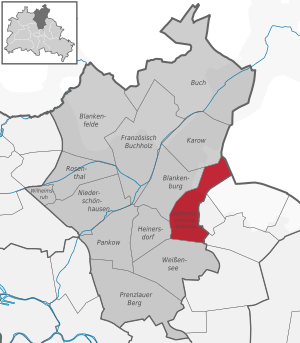Malchow (Berlin)
Malchow [ Malco ː ] is a district of Berlin in the Lichtenberg district. The one with the administrative reform of 2001, the newly formed district of the city Malchow, however, lies in the neighboring district of Pankow.
History
Beginning of settlement to the Middle Ages
Already in the Middle Stone Age ( about 5000 BC ) took advantage of hunters, gatherers and fishermen, the area around Malchow as a resting place. Due to the richness in fish and fertile soils henceforth began the colonization. This is testified by archaeological finds, such as flint tools and heart-shaped arrowheads. In the Early Bronze Age (ca. 1200 BC ) the area was populated and intensively used. Also from the pre-Roman Iron Age and the Early Middle Ages Slavic originate finds of Malchower ground.
During the 13th century German farmers founded the village of Malchow, probably around 1230, like most villages in the Berlin area on the Barnim. The relative carefully gequaderte field stone masonry shows that the early Gothic village church was built in the second half of the 13th century (1945 blown up by members of the Wehrmacht ). 1344 the place Malchow was first mentioned in a deed of Ludwig the Elder ( Margrave of Brandenburg) as Malchowe. In the Land Book of Charles IV of 1375 the village was mentioned by 52 hooves, four parish hooves. It had an inn ( taberna ). In the village lived next to the hooves farmers 28 Kossäten. Even before 1375, the village was the Malchower auxiliary branch of the noble family of Barfus owned. They sold it in 1684 to Paul Fuchs.
Expansion in the 17th century
In 1629 the imperial regiments under Wallenstein camped in Malchow. A blacksmith and a post mill was the place in 1642. Paul Fuchs, a Brandenburg- Prussian Minister of State, replaced in 1684 Blankenburger his possession against the Malchower Good. The remaining years as Malchow heyday called because Paul Fuchs the place to his " noble house" goal for. Under his leadership, a preacher widows 'and orphans' home was built and renovated the church. In the 18th century King Frederick I in succession and then Christian Ludwig of Brandenburg- Schwedt acquired the estate. In addition to the creation of new avenues and the pleasure garden was expanded. From 1734 Malchow was administered by Niederschoenhausen until it - after it was in the 19th century, again under private management - was purchased in 1882 by the city of Berlin, the large areas used as a sewage farm. At this time began selective breeding of edible fish on the shores of Lake Malchow, which was operated until the 1960s. 1920, Malchow was incorporated into Greater Berlin and assigned to the Weissensee district.
New residential areas arise
In the late 1920s Malchow got a bus connection to Weissensee and moved so closer to the city of Berlin. In the 1930s, Malchow expanded through the creation of the settlement Margaret height and built by the Niles NILES- works settlement to the southeast of Lake Malchow.
Around 1955, the former estate in Malchow was converted into public property. The People's Own Good ( VEG) Malchow now served the food production. The spin-off Hohenschönhauser Stockhausen 1985 by Weissensee Malchow was divided. The village center and the settlement Margaretenhöhe belonged to the district since Hohenschonhausen. The suburban settlement remained, however, in the district of Weissensee, which rose in 2001 in the district of Pankow.
The East German plans for Malchow saw in 1990 before the construction of a large housing estate.
Malchow from 1990
Since the district reform in 2001 and the consequent dissolution of the district Hohenschonhausen Malchow belongs to the district of Lichtenberg. The boundaries of the district were also re-cut; the settlement Margaretenhöhe was the village of Wartenberg and the Niles- settlement of the district of New Hohenschonhausen slammed. In terms of population Malchow with 488 inhabitants (as at 31 December 2010) is the smallest district of Berlin.
Monuments
- The medieval village church in the old village center dates from the 13th century. It was completely destroyed in World War II and has not been rebuilt. It still preserves some remains of the enclosing walls. In the ruins of some inscription grave stones of the pastor's family Neander are from the late 17th century.
- At the village street 9 is the former Malchower mansion. It was from 1682 to 1705 in the possession of the Minister of Paul Fox, who transformed it into a baroque castle-like facility. In the following period number of changes have been made. The two-story stucco building with two pavilion-like wings received its present form from 1865 to 1866 in the style of Schinkel's successor. From 1951 to 2004, the building was used by the Faculty of agricultural and horticultural the Humboldt University. The west of the palace -scale baroque pleasure garden is visible only in its infancy.
- Numerous Gutsarbeiterhäuser of the late 19th century
Education, Culture and Nature
- Primary school in the countryside with a children's farm, called tots Farm
- Naturschutzstation, organized the annual Stork Festival
- The pike ditch, Berl and Malchow Lake form the water wealth of the district. The Malchower See also serves as angling.
- The nature reserve Malchower Aue is a little off the lake. It is a breeding and passage area for birds as well as for the conservation of native amphibian species of great importance.









